
written by Prof.
Akira SATOH
on 1st of January,
2012
Results between 2006 and 2010
1.
Self-Organization of Rod-like Hematite Particles ( Cluster-moving
Monte
Carlo Simulations)
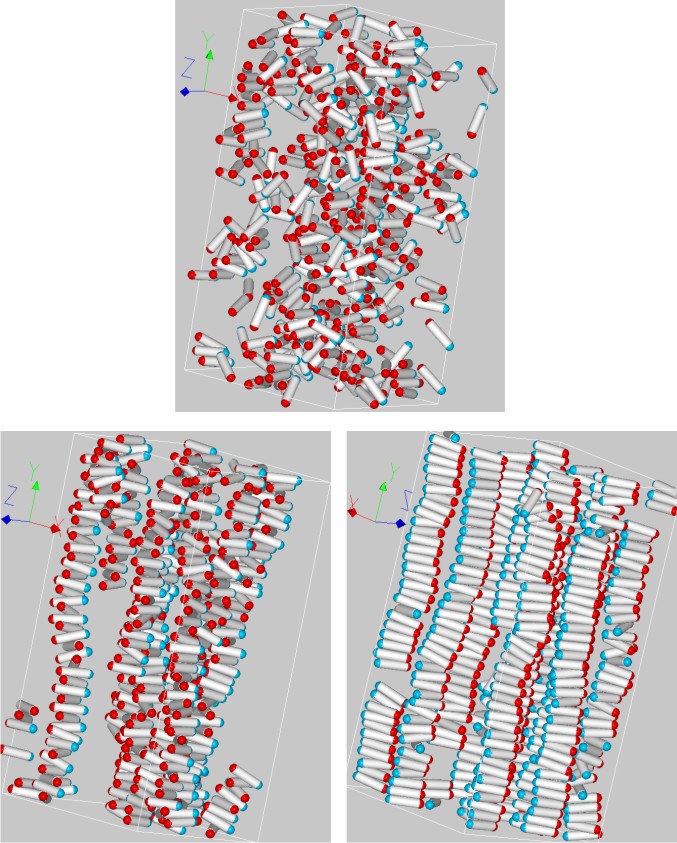
We have treated a suspension composed of ferromagnetic rod‑like
particles with a magnetic
moment normal to the particle axis in order
to
investigate the self-organization of these
particles.
Rod‑like particles tend to aggregate to form raft‑like clusters
along the magnetic moment direction more significantly as magnetic
particle‑particle interactions increase.
(a) For the case of no applied
magnetic field
(b) For the case where the magnetic
interaction
between particles is more dominant than the
applied magnetic
field (the left-hand-side figure)
(c) For the case where the applied magnetic field is more
dominant than the magnetic interaction between particles (the
right-hand-side figure)
2.
Application of the Dissipative Particle Dynamics Method to Magnetic
Suspensions
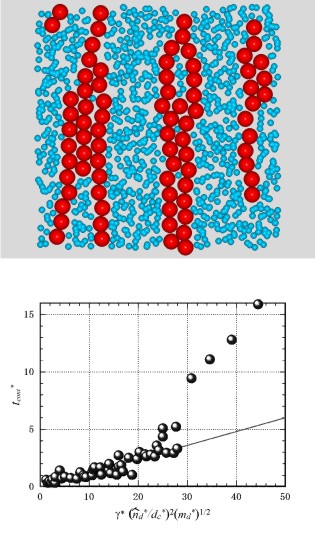
Dissipative particles are regarded as fluid particles
that are
clusters of real solvent molecules. This modeling enables us
to
simulate the dispersed magnetic particles and the dissipative
particles
simultaneously.
The chain-like aggregate structures are in
good agreement with those
of Monte Carlo and Brownian dynamics
simulations.
The dissipative
particle dynamics method is clearly seen to be a
useful technique as a
simulation method for magnetic suspensions.
It is clearly seen from the figure that the results can be
expressed as a
universal line by employing the quantity as abscissa,
proposed in the
present study.
3. Improvement of the Visibility of Water in Rivers and
Lakes by Means
of Applying the Suspension Physics Engineering

Brownian dynamics simulations have been conducted
to
investigate the behavior of two types of spherical
particles, i.e.
adsorption agent particles (large particles
in the figure) and suspended
substance particles (small
particles).
The present study considers
the influences of the
diameter ratio of such particles, the random forces
of
particles due to the Brownian motion, and the thickness
of the initial
layer of large particles.
The snapshots at lower positions are obtained
for
advancing time.
The performance of removing suspended substance particles
has a strong relationship with the particle
Brownian motion.
4.
Development of the Boundary Model in Lattice Boltzmann Method
for Applying
It to Magnetic Suspensions (An Equilibrium Linear YMLS
Boundary
Model)
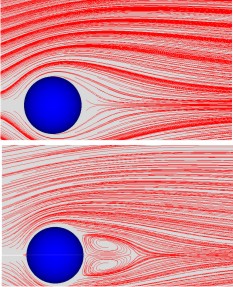
We
have conducted the basic study on the lattice Boltzmann method from the
viewpoint of applying it to magnetic suspensions, by considering a uniform
flow past a two-dimensional circular particle (i.e.,
cylinder).
The
equilibrium linear YMLS boundary model is seen to be available for simulating
particle suspensions.
The employment of the equilibrium linear YMLS
boundary model gives rise to
good agreement with the Navier-Stokes
results concerning the formation of a
pair of vortices behind
the cylinder.
(1) For the case of Reynolds number Re=5 (upper
figure)
(2) For the case of
Reynolds number Re=20 (lower
figure)
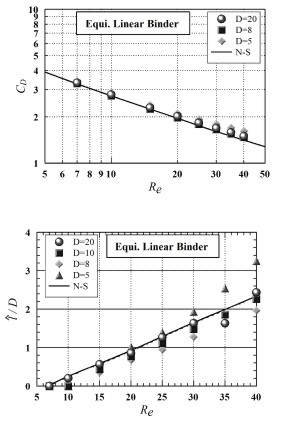
The employment of the equilibrium linear YMLS boundary
model provides the result that the drag coefficient is in
good
aggreeement with that of the Navier-Stokes equations
even if a coarse
lattice system is
used.
The length of a pair of
vortices agrees well with the exact
solution of the Navier-Stokes
equation.
5. Behavior of Oblate Hematite Particles on the Material
Surface for
Application to Surface-Quality-Changing Technology (2D Monte
Carlo
Simulation of the Phase Transition)

The
figure shows the model of a disk-like particle, that is magnetized
in a
direction normal to the particle direction: we employ
the disk-like
particle model which is composed of a short cylinder surrounded
by a
torus part.
A magnetic field is applied in a direction normal to the
material surface.
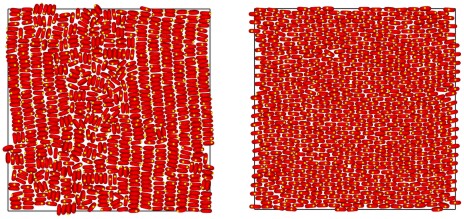
As the magnetic field increases,
a phase change
appears from
column-like (left-hand-side figure)
to brick-wall-like
(right-hand-
side figure)
aggregates.
6. Experimental Study on the Characteristics of a Microjet
in an Electro-
Conjugate Fluid by 2D PIV Analysis
If a high voltage is applied to a pair of
electrodes immersed in a certain dielectric fluid, a strong
microjet occurs
between the electrodes. This is called the electro-conjugate fluid (ECF) effect.
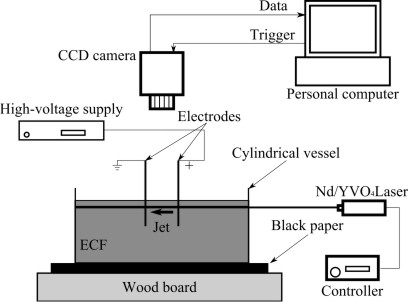
By means of a laser-visualization system, a flow
field
can be visualized and the digital data
of the flow field
is obtained by the PIV
analysis.
In present study, we use a dibutyl decanedioate (DBD) with 98 %
purity which is the most typical
electro-conjugate fluid. This fluid
has
a high boiling point and can be treated straightforwardly
in
the experiment.
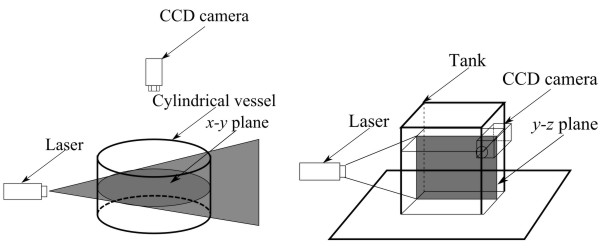
By visualizing, using a laser light,
the flow
field both on the horizontal
and vertical
planes, 3D information concerning
the flow
field is obtained.
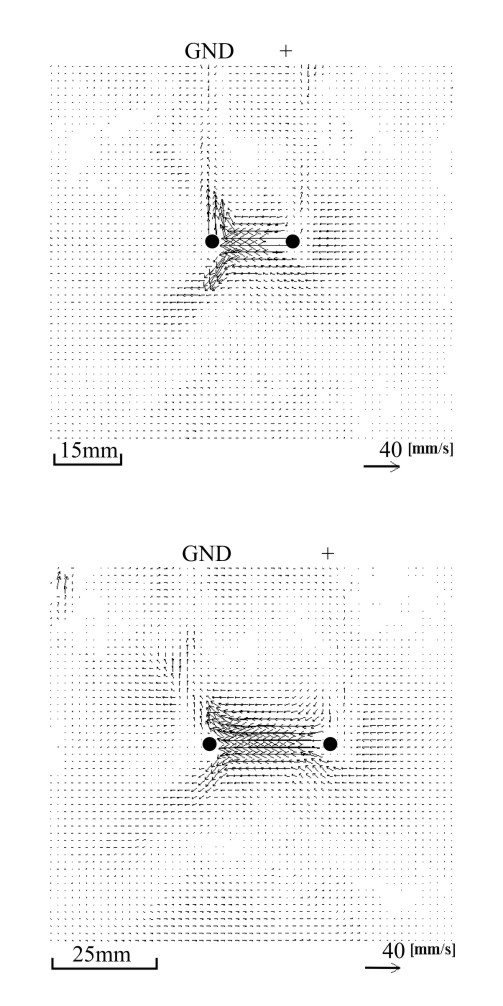
A microjet appears
from the right positive electrode toward
the left negative
electrode.
(1) For the case of a narrow separation of the
electrodes
(2) For the case of a wide separation of the
electrodes

The figure shows the flow
field on a vertical plane.
The flow is induced from the right
positive electrode in
an oblique direction (i.e., in the left-down
direction).
7. Negative Magneto-Rheological Effect of a Dispersion
Composed of Spindle-like Hematite
Particles
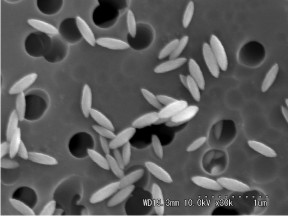
The
spindle-like hematite particles were synthesized by aging a solution of
FeCl3
and
KH2PO4 for 72 hours at
373K.
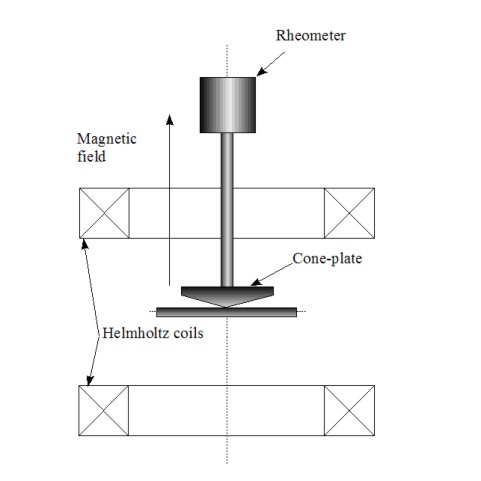
The measurement of the viscosity was carried out using
the rotational-type rheometer in an external magnetic
field generated by
the Helmholtz
coils.
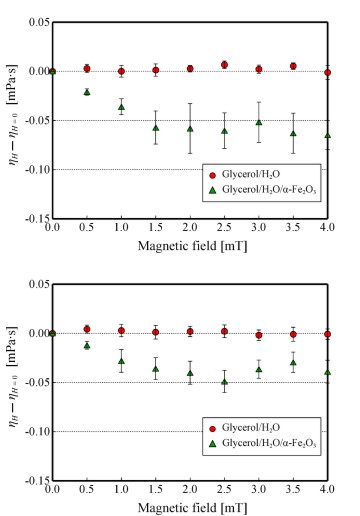
The present experiment has
first verified that the negative
viscosity DOES APPEAR with increasing
applied magnetic
field strength.
(1) For the case of a weak
shear flow
(2) For the case of a
strong shear flow
The Negative viscosity
has been predicted by our theoretical observation and
the present experiment
has first verified the appearance of the negative viscosity.
END. 














